8.6 THREATENED BIODIVERSITY IN SOUTHEAST
ASIAN RIVER BASINS
Riverine birds / Mammals of floodplain grasslands / River dolphins / Riverine forest mammals / Crocodilians / Turtles
Mekong
molluscs--
The biodiversity of invertebrates in Asian rivers has been less studied
than that of fishes, but some taxa are certainly highly speciose (Dudgeon
1999). For example, the mollusc fauna in the lower Mekong Basin includes
species-flocks of stenothyrid 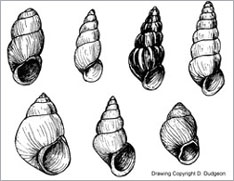 and
pomatiopsid snails (>110 endemic species); a similar radiation has
occurred in the Yangtze River, China. The Mobile Bay Basin in the southeastern
United States once supported the most diverse freshwater mollusc assemblage
in the world (Groombridge and Jenkins 1998), but one third of them have
been driven to extinction by flow regulation and habitat alteration. As
a result, with over 160 species, the lower Mekong now supports the richest
fauna. This is despite the fact that much of the river course has not
been surveyed for molluscs. The richness of stenothyrids and pomatiopsids
is related to their dietary and habitat specialism (Attwood 1995a): some
species prefer muddy substrates, others occur on sand, on rocks or on
submerged wood. Flow regulation in the Mekong would lead to changes in
food availability and substrate characteristics that might impact some
snails while favouring others – in particular, Neotricula aperta,
a host of the human blood fluke parasite Schistosoma mekongi (Attwood
1995b).
and
pomatiopsid snails (>110 endemic species); a similar radiation has
occurred in the Yangtze River, China. The Mobile Bay Basin in the southeastern
United States once supported the most diverse freshwater mollusc assemblage
in the world (Groombridge and Jenkins 1998), but one third of them have
been driven to extinction by flow regulation and habitat alteration. As
a result, with over 160 species, the lower Mekong now supports the richest
fauna. This is despite the fact that much of the river course has not
been surveyed for molluscs. The richness of stenothyrids and pomatiopsids
is related to their dietary and habitat specialism (Attwood 1995a): some
species prefer muddy substrates, others occur on sand, on rocks or on
submerged wood. Flow regulation in the Mekong would lead to changes in
food availability and substrate characteristics that might impact some
snails while favouring others – in particular, Neotricula aperta,
a host of the human blood fluke parasite Schistosoma mekongi (Attwood
1995b).
Riverine
birds--
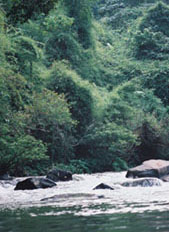 Although
Asia is home to around half the global total of specialist river bird
species, fewer than 10% of scientific publications on these animals deal
with Asian species (Ormerod 1999). Although this limits our knowledge
of river bird biodiversity in Southeast Asia, many species are declining
in range and abundance. The White-eyed river martin (Pseudochelidon
sirintarae) is already extinct.
Although
Asia is home to around half the global total of specialist river bird
species, fewer than 10% of scientific publications on these animals deal
with Asian species (Ormerod 1999). Although this limits our knowledge
of river bird biodiversity in Southeast Asia, many species are declining
in range and abundance. The White-eyed river martin (Pseudochelidon
sirintarae) is already extinct.
Data from Lao PDR (Lekagul and Round 1991; Duckworth et al., 1998; Thewlis
et al., 1998) illustrate the fate of river birds in Asia. Lao PDR
retains a higher proportion of forest cover than its neighbours, and substantial
lengths of riverine forest. It is therefore likely to support a more complete
assemblage of river birds. In addition, because Lao PDR is land-locked,
these birds are not able to use estuaries or mangroves as alternative
wetland habitats, and their population status accurately reflects the
extent of human impacts on rivers.
Twenty-four Laotian bird species associated
with rivers have declined over the last 50 years and are now absent from
large areas of suitable habitat. Thirty-one of the 44 species classified
as at risk in Lao PDR are wetland birds. Species such as the Indian skimmer
(Rhychops albicolis) are globally endangered (Collar et al.,
1994; IUCN 2000), while the Black-bellied tern (Sterna acuticauda),
Great thick-knee (Esacus magnirostris), and Oriental darter (Anhinga
melanogaster) are globally near-threatened.
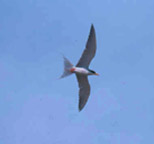 |
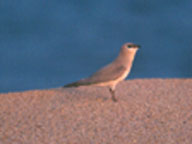 |
Birds associated with sandbars on large
rivers in Lao PDR and elsewhere have declined greatly due, in part, to
human disturbance of nesting sites. The River lapwing (Vanellus duvaucelii),
Great thick-knee, River tern (Sterna aurantia), Black-bellied tern and
Little tern (Sterna albifrons) are approaching national extinction
in Lao PDR, and the Great thick-knee, River tern, Black-bellied tern,
and Indian skimmer are already extinct in Thailand (Lekagul and Round
1991). The Plain martin (Riparia paludicola), which has declined
in Lao PDR and Thailand, nests in burrows on sandbars – a habit it
probably shared with the extinct White-eyed river martin.
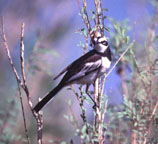 A
new species of river bird endemic to the lower Mekong basin – Motacilla
samveasnae, the Mekong wagtail – was described in 2001. It is restricted
to wide braided channels in lowland areas subject to seasonal flooding,
and concentrates along earthen banks and overhanging vegetation when water
levels are high. Its restricted distribution makes it vulnerable to habitat
alteration. Modification of flow and sedimentation patterns (caused by,
for example, flow regulation) would put the Mekong wagtail at risk (Davidson
et al., 2001).
A
new species of river bird endemic to the lower Mekong basin – Motacilla
samveasnae, the Mekong wagtail – was described in 2001. It is restricted
to wide braided channels in lowland areas subject to seasonal flooding,
and concentrates along earthen banks and overhanging vegetation when water
levels are high. Its restricted distribution makes it vulnerable to habitat
alteration. Modification of flow and sedimentation patterns (caused by,
for example, flow regulation) would put the Mekong wagtail at risk (Davidson
et al., 2001).
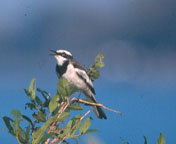 The
wetlands of the lower Mekong support a number of globally-threatened species,
and The Great Lake (Lake Tonlé Sap) holds the largest breeding
colonies of large water birds in Asia (Edwards 2001). Among them are the
critically endangered Giant ibis (Pseudibis gigantea); the endangered
Greater adjutant (Leptoptilos dubius), White-shouldered ibis (Pseudibis
davisoni), White-winged duck (Cairina scutulata), Bengal florican
(Eupodotis bengalensis), and Nordmann's greenshank (Tringer guttifer);
the vulnerable Spot-billed pelican (Pelecanus philippensis), Lesser adjutant
(Leptoptilos javanicus), Milky stork (Myteria cinerea), and Masked
finfoot (Heliopais personata).
The
wetlands of the lower Mekong support a number of globally-threatened species,
and The Great Lake (Lake Tonlé Sap) holds the largest breeding
colonies of large water birds in Asia (Edwards 2001). Among them are the
critically endangered Giant ibis (Pseudibis gigantea); the endangered
Greater adjutant (Leptoptilos dubius), White-shouldered ibis (Pseudibis
davisoni), White-winged duck (Cairina scutulata), Bengal florican
(Eupodotis bengalensis), and Nordmann's greenshank (Tringer guttifer);
the vulnerable Spot-billed pelican (Pelecanus philippensis), Lesser adjutant
(Leptoptilos javanicus), Milky stork (Myteria cinerea), and Masked
finfoot (Heliopais personata).